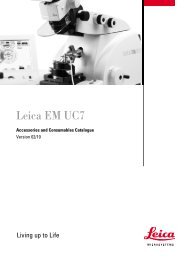Physical Principles of Electron Microscopy: An Introduction to TEM ...
Physical Principles of Electron Microscopy: An Introduction to TEM ...
Physical Principles of Electron Microscopy: An Introduction to TEM ...
You also want an ePaper? Increase the reach of your titles
YUMPU automatically turns print PDFs into web optimized ePapers that Google loves.
The Transmission <strong>Electron</strong> Microscope 61<br />
(used in cathode-ray tubes) are even more sensitive <strong>to</strong> ambient gas and are<br />
not used in the <strong>TEM</strong>.<br />
Compared <strong>to</strong> a tungsten filament, the LaB6 source is relatively expensive<br />
(� $1000) but lasts longer, provided it is brought <strong>to</strong> and from its operating<br />
temperature slowly <strong>to</strong> avoid thermal shock and the resulting mechanical<br />
fracture. It provides comparable emission current from a smaller cathode<br />
area, enabling the electron beam <strong>to</strong> be focused on<strong>to</strong> a smaller area <strong>of</strong> the<br />
specimen. The resulting higher current density provides a brighter image at<br />
the viewing screen (or camera) <strong>of</strong> the <strong>TEM</strong>, which is particularly important<br />
at high image magnification.<br />
<strong>An</strong>other important component <strong>of</strong> the electron gun (Fig. 3-1) is the<br />
Wehnelt cylinder, a metal electrode that can be easily removed (<strong>to</strong> allow<br />
changing the filament or LaB6 source) but which normally surrounds the<br />
filament completely except for a small (< 1 mm diameter) hole through<br />
which the electron beam emerges. The function <strong>of</strong> the Wehnelt electrode is<br />
<strong>to</strong> control the emission current <strong>of</strong> the electron gun. For this purpose, its<br />
potential is made more negative than that <strong>of</strong> the cathode. This negative<br />
potential prevents electrons from leaving the cathode unless they are emitted<br />
from a region near <strong>to</strong> its tip, which is located immediately above the hole in<br />
the Wehnelt where the electrostatic potential is less negative. Increasing the<br />
magnitude <strong>of</strong> the negative bias reduces both the emitting area and the<br />
emission current Ie.<br />
Although the Wehnelt bias could be provided by a voltage power supply,<br />
it is usually achieved through the au<strong>to</strong>bias (or self-bias) arrangement shown<br />
in Figs. 3-1 and 3-6. A bias resis<strong>to</strong>r Rb is inserted between one end <strong>of</strong> the<br />
filament and the negative high-voltage supply (�V0) that is used <strong>to</strong> accelerate<br />
the electrons. Because the electron current Ie emitted from the filament F<br />
must pass through the bias resis<strong>to</strong>r, a potential difference (IeRb) is developed<br />
across it, making the filament less negative than the Wehnelt. Changing the<br />
value <strong>of</strong> Rb provides a convenient way <strong>of</strong> intentionally varying the Wehnelt<br />
bias and therefore the emission current Ie. A further advantage <strong>of</strong> this<br />
au<strong>to</strong>bias arrangement is that if the emission current Ie starts <strong>to</strong> increase<br />
spontaneously (for example, due <strong>to</strong> upward drift in the filament temperature<br />
T ) the Wehnelt bias becomes more negative, canceling out most <strong>of</strong> the<br />
increase in electron emission. This is another example <strong>of</strong> the negative<br />
feedback concept discussed previously (Section 1.7).<br />
The dependence <strong>of</strong> electron-beam current on the filament heating current<br />
is shown in Fig. 3-3. As the current is increased from zero, the filament<br />
temperature eventually becomes high enough <strong>to</strong> give some emission current.<br />
At this point, the Wehnelt bias (�IeRb) is not sufficient <strong>to</strong> control the emitting



